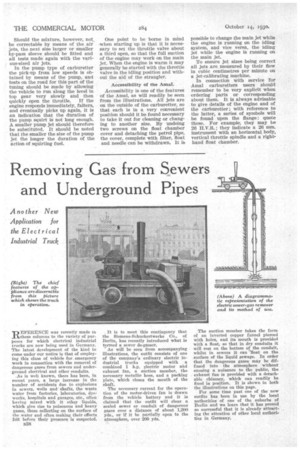Removing Gas from Sewers and Underground Pipes
Page 64

If you've noticed an error in this article please click here to report it so we can fix it.
REFERENCE was recently made m )these columns to the variety of purposes for which electrical industrial trucks are now being used in Germany. The latest development of the kind to come under our notice is that of employing this class of vehicle for emergency work in connection with the removal of dangerous gases from sewers and underground electrical and other conduits.
As is well known, there has been, in recent years, a large increase in the number of accidents due to explosions in sewers, wells and shafts, the waste water from factories, laboratories, dye. works, hospitals and garages, etc., often having mixed with it oth‘r liquids, which give rise to poisonous and heavy gases, these collecting on the surface of the water and often making their effects felt before their presence is suspected. • It is to meet this contingency that the Siemens-Schuckertwerke Co., of Berlin, has recently introduced what is termed a sewer de-gasser.
As will be seen from accompanying illustrations, the outfit consists of one of the company's ordinary electric industrial trucks equipped with a combined 1 h.p. electric motor and exhaust fan, a suction member, the necessary metallic hose, and a packing plate, which closes the mouth of the shaft.
The necessary current for the operation of the motor-driven fan is drawn from the vehicle battery and it is claimed that the outfit will clear a sealed sewer or conduit of dangerous gases over a distance of about 1,200 yds., or if it be partially open to the atmosphere, over 200 yds.
The suction member takes the form of an inverted copper funnel pierced with holes, and its mouth is provided with a float, so that in dry conduits it will rest on the bottom of the conduit, whilst in sewers it can 'float on the surface of the liquid sewage. In order that the dangerous gases may be diffused into the atmosphere without causing a nuisance to the public, the exhaust fan is provided with a detachable chimney, which can readily be fixed in position. It is shown in both the illustrations on this page.
For some time past one of the new outfits has been in use by the local authorities of one of the suburbs of Berlin and we learn that it has proved so successful that it is already attracting the attention of other local authorities in Germany.




















































































































